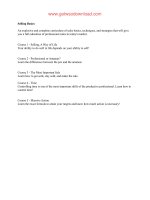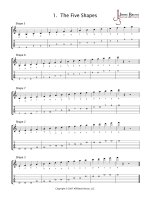1 1 1 intro to algos tủ tài liệu training pdf
Bạn đang xem bản rút gọn của tài liệu. Xem và tải ngay bản đầy đủ của tài liệu tại đây (1.11 MB, 12 trang )
Design and Analysis
of Algorithms I
Introduction on
Why Study
Algorithms?
Why Study Algorithms?
• important for all other branches of computer science
Nextcore AI Gopal Shangari
WHY STUDY ALGORITHMS?
• important for all other branches of computer science
• plays a key role in modern technological innovation
Nextcore AI Gopal
Shangari
WHY STUDY ALGORITHMS?
• important for all other branches of computer science
• plays a key role in modern technological innova t i on
– “Everyone knows Moore’s Law – a prediction made in 1965 by Intel co-‐
founder Gordon Moore that the density of transistors in integrated
circuits would cont i nue to double every 1 to 2 years….in many areas,
performance gains due to improvements in algorithms have vastly
exceeded even the drama t i c performance gains due to increased
processor speed.”
• Excerpt from Report to the President and Congress: Designing a Digital Future,
December 2010 (page 71).
Nextcore AI Gopal
Shangari
WHY STUDY ALGORITHMS?
• important for all other branches of computer science
• plays a key role in modern technological innova t i on
• provides novel “lens” on processes outside of
computer science and technology
– quantum mechanics, economic markets, evolution
Nextcore AI Gopal
Shangari
WHY STUDY ALGORITHMS?
• important for all other branches of computer science
• plays a key role in modern technological innova t i on
• provides novel “lens” on processes outside of
computer science and technology
• challenging
Nextcore AI Gopal
Shangari
WHY STUDY ALGORITHMS?
• important for all other branches of computer science
• plays a key role in modern technological innova t i on
• provides novel “lens” on processes outside of
computer science and technology
• challenging
• fun
Nextcore AI Gopal
Shangari
INTEGER MUTLIPLICATION
Input : 2 n digit numbers x and y
Output : product x*y
“Primitive Opera t i on” -‐ add or multiply 2 single digit
numbers
Nextcore AI Gopal
Shangari
THE GRADE-‐SCHOOL ALGORITHM
Roughly n opera t i ons
per row up to a constant
# of opera t i ons overall ~
constant*
Nextcore AI Gopal
Shangari
THE ALGORITHM DESIGNER’S MANTRA
“Perhaps the most important principle for the good
algorithm designer is to refuse to be content.”
-‐Ullman, The Design and Analysis of
Computer Algorithms, 1974
CAN WE DO BETTER ?
[ than the “obvious” method]
Nextcore AI Gopal
Shangari
Recursive
algorithm
Write
and
Where a,b,c,d are n/2-‐ digit numbers.
[example: a=56, b=78, c=12, d=34] Then
Idea : recursively compute ac, ad, bc, bd, then
compute (* in the obvious way
Nextcore AI Gopal
Shangari
Karatsuba Multiplication
1. Recursively compute ac
2. Recursively compute bd
3. Recursively compute (a+b)(c+d) = ac+bd+ad+bc
Gauss’ Trick : (3) – (1) – (2) = ad + bc
Upshot : Only need 3 recursive multiplications (and some additions)
Q: which is the fastest algorithm ?
Nextcore AI Gopal
Shangari









